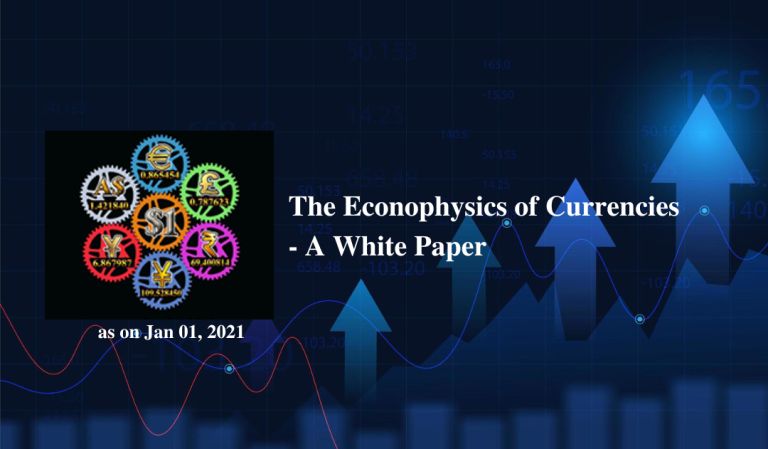The Econophysics of Currencies-A White Paper

After the collapse of the fixed exchange rates regime under the Bretton Woods Agreement in 1971, the floating regime rose as the new regime for cross-border trade. Right from its outset, expansionary economic policies, especially of the advanced nations, have waggled and distressed the system. Money was cut free from its gold mooring and it began to be printed recklessly to high heavens. Under its new uncertain realm, currency and financial crises became the norm which devasted economies like Mexico, South Korea, Thailand, Malaysia, South Korea, Indonesia, Russia and Argentina.
Textbooks theorized a mixture of GDP, interest and inflation rates and other elements for determination of exchange rates but what prevailed over such a potpourri, was the schizophrenic rates spewed out by speculators at the currency market. At present, they dominate 97% of all the trades and the international traders and investors for whom the system was created, was made irrelevant in it.
Floating rates unleashed a systemic enigma in the international monetary regime. The original sin was bundling of currencies along with stocks and bonds for their evaluations. In direct contrast to the Bretton Woods system, nations could intervene in the markets with their reserves to maintain their currency values. Only the rich nations possess the resources for such games, throwing off developing nations as naïve losers, in the currency market casino all the time.
It’s the 21st Century. With all the advances we have achieved in science and technology, it is curious, that the exchange dilemma exists. We cannot continue with the untenable regime, but it must be replaced, with an equitable one for the welfare of all nations. We already had it under the Classical Gold Standard. It was designed by scientists, rather than economists, at the end of the 19th century, at a time when extraordinary advances were being made in science. All national currencies were fixed against each other, through a specific weight of gold – a commodity link to the real economy of nations. It worked well, till the outbreak of the First World War.
We can return to a similar mechanism, but without the gold. Just as it was done during the introduction of the Euro, nations could fix permanently the exchange rates of their currencies against the US dollar, like a measurement tool. For the exchange rate, a spot rate or any average rate could be adopted, as it would not make any difference. The exchange rate would be rendered as a conduit for exchange of currencies, like the exchange of a US10 dollar note for ten US1 dollar notes. The 1871 price of 4.21 pounds and $20.67 for an ounce of gold, defined effectively the exchange rate between the British Pound and the US Dollar, at 1lb for $4.87. This exchange rate could have been continued till date, without losses to anyone, though the gold price has changed massively. What matters most, are the domestic prices of goods which would have moved positively or negatively, in all the years till date. Those changes could have been adjusted, in the exchange rate dynamically during transactions, as a cost factor. In such an architecture of the exchange rate, the domestic price of any product turns into a pivot point, from where the purchasing power of a currency is realized.
In comparison with domestic prices, the nominal exchange rates is destabilised more frequently. Hence, it’s crucial to return to the Classical Gold Standard, whereby currencies were evaluated through the real economy of each nation. It could be interpreted, as evaluations based on the science of locational economics or the econophysics of currencies.
Econophysics is a new science which incorporates economics and physics in its application. Its evaluations are natural, transparent and uninhibited by any dubious economic theories or human sentiment.
The intervention in the currency markets by central banks and the prevailing currency swap agreements between countries, evidences the avowed desires of nations for stable exchange rates.
In line with the above wishes of nations, RECIPRO facilitates the following types of exchange rates for the usage of traders in their transactions, subject to their governments’ approvals.
Foreign Exchange Rates as on 1st January 2021
Trade partners may adopt the exchange rates as determined by the markets as on 1st January 2021, for their transactions permanently. As explained under the econophysics of currencies above, the fixed exchange rates enable dynamic evaluation of a product in any currency immediately.
Negotiated Foreign Exchange Rates
Traders can adopt any exchange rate at the time of entering a trade contract, but must stick to it at the time of its execution, even though the relevant market rate may have moved unfavorably against a party. The compensatory trade enables equitable exchange of goods.
Evidence: Shackled Minds Disrupted Cross-Border Trade
A nation’s currency depreciated by 57%, within two years of its rate, in June 2017 and it had to stop totally its import of an essential commodity, in 2019 from a neighbouring country. The author noticed, that the relevant commodity’s local currency price did not even rise above 10% within the relevant period and recommended to the concerned government, that they could still import the commodity by making payments in the exporting country’s currency, rather than in US Dollars. Within a month, the relevant governments entered a barter trade agreement and resumed the trade of the commodity.
Unfortunately, many nations are still managing their economies thoughtlessly, with dubious economic theories.